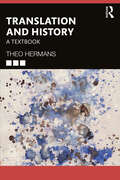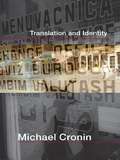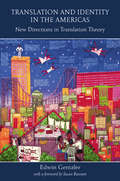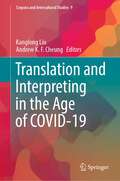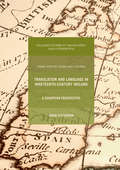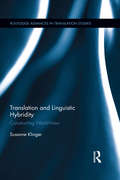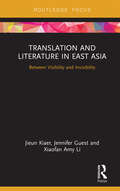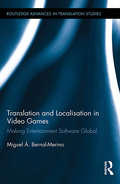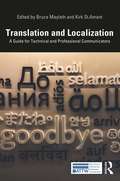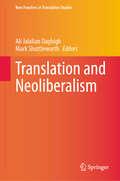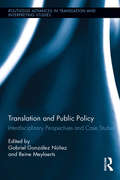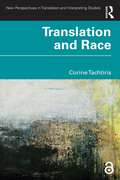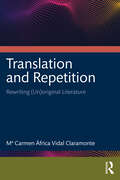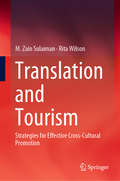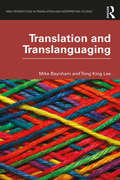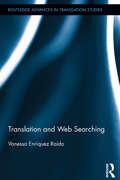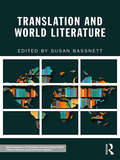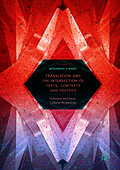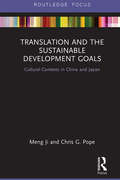- Table View
- List View
Translation and History: A Textbook
by Theo HermansThis concise and accessible textbook is a comprehensive introduction to the key historical aspects of translation. Six chapters cover essential concepts in researching and writing the history of translation and translation as history. Theo Hermans presents and explains fundamental issues and questions in a clear and lively style. He includes numerous examples and case studies and offers suggestions for further reading. Four of the six chapters take their cue from ideas about historiography that are alive among professional historians. They pay attention to the role of narrative, to the emergence of transnational, transcultural, global and entangled history, and to particular fields such as the history of concepts and memory studies. Other topics include microhistory, actor–network theory and book history. With an emphasis on methodology, how to do research in translation history and how to write it up, this is an essential text for all courses on translation history and will be of interest to anyone working in translation theory and methodology.
Translation and Identity
by Michael CroninMichael Cronin looks at how translation has played a crucial role in shaping debates about identity, language and cultural survival in the past and in the present. He explores how everything from the impact of migration on the curricula for national literature courses, to the way in which nations wage war in the modern era is bound up with urgent questions of translation and identity. Examining translation practices and experiences across continents to show how translation is an integral part of how cultures are evolving, the volume presents new perspectives on how translation can be a powerful tool in enhancing difference and promoting intercultural dialogue. Drawing on a wide range of materials from official government reports to Shakespearean drama and Hollywood films, Cronin demonstrates how translation is central to any proper understanding of how cultural identity has emerged in human history, and suggests an innovative and positive vision of how translation can be used to deal with one of the most salient issues in an increasingly borderless world.
Translation and Identity in the Americas: New Directions in Translation Theory
by Edwin GentzlerTranslation is a highly contested site in the Americas where different groups, often with competing literary or political interests, vie for space and approval. In its survey of these multiple and competing groups and its study of the geographic, socio-political and cultural aspects of translation, Edwin Gentzler’s book demonstrates that the Americas are a fruitful terrain for the field of translation studies. Building on research from a variety of disciplines including cultural studies, linguistics, feminism and ethnic studies and including case studies from Brazil, Canada and the Caribbean, this book shows that translation is one of the primary means by which a culture is constructed: translation in the Americas is less something that happens between separate and distinct cultures and more something that is capable of establishing those very cultures. Using a variety of texts and addressing minority and oppressed groups within cultures, Translation and Identity in the Americas highlights by example the cultural role translation policies play in a discriminatory process: the consequences of which can be social marginalization, loss of identity and psychological trauma. Translation and Identity the Americas will be critical reading for students and scholars of Translation Studies, Comparative Literature and Cultural Studies.
Translation and Interpreting in the Age of COVID-19 (Corpora and Intercultural Studies #9)
by Kanglong Liu Andrew K. F. CheungThis book presents the latest developments in translation and interpreting (T&I), which has been at the forefront to face the challenges brought by COVID-19. The contributions in the book contain both quantitative and qualitative empirical studies as well as personal accounts of the impact and opportunities T&I has faced in the global pandemic, covering topics including metaphor translation, delivery of and access to T&I services during COVID-19, renewed perspectives on T&I practice and profession, and technological applications in the T&I classroom. The various themes in the book, through examining the role and many facets of T&I against the backdrop of COVID-19, have demonstrated that T&I as a vital means of intercultural communication is assuming immense importance at a time of uncertainties and disruptions.As one of the books addressing crucial issues of T&I at a time of global crisis, this edited book is of interest to many T&I professionals, researchers, teachers, and students who have been impacted by the pandemic and yet showed a continued interest in T&I and its future emerging practice in the post-pandemic era.
Translation and Language in Nineteenth-Century Ireland
by Anne O’connorThis book will provide an in-depth study of translation and translators in nineteenth-century Ireland and will use translation history to widen our understanding of cultural exchange in this period, creating new perspectives on historical, political and cultural debates of the era.
Translation and Linguistic Hybridity: Constructing World-View (Routledge Advances in Translation and Interpreting Studies)
by Susanne KlingerThis volume outlines a new approach to the study of linguistic hybridity and its translation in cross-cultural writing. By building on concepts from narratology, cognitive poetics, stylistics, and film studies, it explores how linguistic hybridity contributes to the reader’s construction of the textual agents’ world-view and how it can be exploited in order to encourage the reader to empathise with one world-view rather than another and, consequently, how translation shifts in linguistic hybridity can affect the world-view that the reader constructs. Linguistic hybridity is a hallmark of cross-cultural texts such as postcolonial, migrant and travel writing as source and target language come into contact not only during the process of writing these texts, but also often in the (fictional or non-fictional) story-world. Hence, translation is frequently not only the medium, but also the object of representation. By focussing on the relation between medium and object of representation, the book complements existing research that so far has neglected this aspect. The book thus not only contributes to current scholarly debates – within and beyond the discipline of translation studies – concerned with cross-cultural writing and linguistic hybridity, but also adds to the growing body of translation studies research concerned with questions of voice and point of view.
Translation and Literature in East Asia: Between Visibility and Invisibility (Routledge Studies In East Asian Translation Ser.)
by Jieun Kiaer Jennifer Guest Xiaofan Amy LiTranslation and Literature in East Asia: Between Visibility and Invisibility explores the issues involved in translation between Chinese, Japanese and Korean, as well as from these languages into European languages, with an eye to comparing the cultures of translation within East Asia and tracking some of their complex interrelationships. This book reasserts the need for a paradigm shift in translation theory that looks beyond European languages and furthers existing work in this field by encompassing a wider range of literature and scholarship in East Asia. Translation and Literature in East Asia brings together material dedicated to the theory and practice of translation between and from East Asian languages for the first time.
Translation and Localisation in Video Games: Making Entertainment Software Global (Routledge Advances in Translation and Interpreting Studies)
by Miguel Bernal-MerinoThis book is a multidisciplinary study of the translation and localisation of video games. It offers a descriptive analysis of the industry – understood as a global phenomenon in entertainment – and aims to explain the norms governing present industry practices, as well as game localisation processes. Additionally, it discusses particular translation issues that are unique to the multichannel nature of video games, in which verbal and nonverbal signs must be cohesively combined with interactivity to achieve maximum playability and immerse players in the game’s virtual world. Although positioned within the theoretical framework of descriptive translation studies, Bernal-Merino incorporates research from audiovisual translation, software localisation, computer assisted translation, comparative literature, and video game production. Moving beyond this framework, Translation and Localisation in Video Games challenges some of the basic tenets of translation studies and proposes changes to established and unsatisfactory processes in the video game and language services industries.
Translation and Localization: A Guide for Technical and Professional Communicators (ATTW Series in Technical and Professional Communication)
by Kirk St. Amant Bruce MaylathDetailed yet accessible, Translation and Localization brings together the research and insights of veteran practicing translators to offer comprehensive guidance for technical communicators. The volume begins with the fundamentals of translation before leading readers through the process of preparing technical documents for translation. It then presents the broader area of localization, again beginning with its key competencies. Concluding chapters examine the state of the field as computers take on more translation and localization work. Featuring real-life scenarios and a broad range of experienced voices, this is an invaluable resource for technical and professional communicators looking to expand into international markets. This book will be of interest to students of ethnic conflict, Asian politics, and security studies.
Translation and Neoliberalism (New Frontiers in Translation Studies)
by Mark Shuttleworth Ali Jalalian DaghighThis book explores the intersections of neoliberalism, translation, and interpreting, a scarcely explored topic in the field of translation studies across diverse regions, including Europe, North America, Asia, and Australia, covering four primary themes that offer unique perspectives on how neoliberal ideologies influence translation and interpreting. The first theme uses data triangulation to delve into the influence of market-driven ideologies on translation and interpreting curriculum globally as well as the neoliberal tendencies of the trainees in China and Korea. The second theme investigates the effects of top-down neoliberal policies on translation services and practices in Australia, Canada, and the UAE, examining how these policies influence service quality, working conditions, and the balance between market demands and academic requirements. The third theme assesses the influence of technology and neoliberalism on the translation and interpreting labor market, providing a critical analysis of the automation of translation workflows, the rise of non-standard employment arrangements, and the socio-economic challenges faced by translation professionals. The final theme analyzes the intersection of neoliberalism and translation at the discourse level, employing various approaches including critical discourse analysis and content analysis to explore how neoliberal values manifest in translated texts and practices in China, Iran, and USA. This book is an essential resource for academics, postgraduate students, researchers, policymakers, educators, and practitioners interested in the dynamic interplay between neoliberalism and translation, offering new insights and critical perspectives that contribute to a deeper understanding of the socio-economic forces shaping the field of translation and interpreting.
Translation and Own-Language Use in Language Teaching: The Quest for Optimal Practice
by Eva SkopečkováThis book reconsiders the role of translation and own-language use in the EFL (English as a Foreign Language) classroom. It shows prospective teachers how to use the learners’ own language and translation optimally. The author surveys current research about the EFL classroom and presents both a theoretical framework and a didactic model for using translation and learners’ mother tongues. This is done through an action research project, assessing the proposed didactic model for optimal translation practice in English Language teaching (OTP in ELT) through its integration into teacher education. The book will be of interest to students and researchers in the areas of Translation Studies and Applied Linguistics (particularly EFL, ESL, TEFL and TESOL), as well as educators and designers of pre-service training programmes for language teachers.
Translation and Practice Theory (Translation Theories Explored)
by Maeve OlohanTranslation and Practice Theory is a timely and theoretically innovative study linking professional practice and translation theory, showing the usefulness of a practice-theoretical approach in addressing some of the challenges that the professional world of translation is currently facing, including, for example, the increasing deployment of machine translation. Focusing on the key aspects of translation practices, Olohan provides the reader with an in-depth understanding of how those practices are performed, as translators interact with people, technologies and other material resources in the translation workplace. The practice-theoretical perspective helps to describe and explain the socio-material complexities of present-day commercial translation practice but also offers a productive approach for studies of translation and interpreting practices in other settings and periods. This first book-length exploration of translation through the lens of practice theory is key reading for advanced students and researchers of Translation Theory. It will also be of interest in the area of professional communication within Communication Studies and Applied Linguistics.
Translation and Pragmatics: Theories and Applications
by Louisa DesillaTranslation and Pragmatics aims to provide a fundamental grounding of key phenomena, theories, and concepts in the field of pragmatics and of some of their manifestations both within and across languages and cultures. The originality of this textbook largely resides in its pedagogical approach which involves familiarising students with the pragmatic phenomena of deixis, speech acts, implicature, and (im)politeness first and foremost through a systematic exposure to concrete, authentic data from a broad spectrum of texts and media (e.g., ads, memes, films, videogames) while showcasing how these phenomena are relayed in different types of translation. With warm-up exercises, illustrative case studies, mini-research activities as well as further reading, this is an essential textbook for translation and intercultural communication students but can also be a useful resource for anyone interested in the interface between pragmatics, translation and/or intercultural communication, media, and the synergies thereof.
Translation and Public Policy: Interdisciplinary Perspectives and Case Studies (Routledge Advances in Translation and Interpreting Studies)
by Reine Meylaerts Gabriel González NúñezThis book brings together an ensemble of leading voices from the fields of economics, language policy, law, political philosophy, and translation studies. They come together to provide theoretical perspectives and practical case studies regarding a shared concern: translation policy. Their timely perspectives and case studies allow for the problematizing and exploration of translation policy, an area that is beginning to come to the attention of scholars. This book offers the first truly interdisciplinary approach to an area of study that is still in its infancy. It thus makes a timely and necessary contribution. As the 21st century marches on, authorities are more and more confronted with the reality of multilingual societies, and the monolingual state polices of yesteryear seem unable to satisfy increasing demands for more just societies. Precisely because of that, language policies of necessity must include choices about the use or non-use of translation at different levels. Thus, translation policy plays a prominent yet often unseen role in multilingual societies. This role is shaped by tensions and compromises that bear on the distribution of resources, choices about language, legal imperatives, and notions of justice. This book aims to inform scholars and policy makers alike regarding these issues.
Translation and Race (New Perspectives in Translation and Interpreting Studies)
by Corine TachtirisTranslation and Race brings together translation studies with critical race studies for a long-overdue reckoning with race and racism in translation theory and practice. This book explores the "unbearable whiteness of translation" in the West that excludes scholars and translators of color from the field and also upholds racial inequities more broadly. Outlining relevant concepts from critical race studies, Translation and Race demonstrates how norms of translation theory and practice in the West actually derive from ideas rooted in white supremacy and other forms of racism. Chapters explore translation’s role in historical processes of racialization, racial capitalism and intellectual property, identity politics and Black translation praxis, the globalization of critical race studies, and ethical strategies for translating racist discourse. Beyond attempts to diversify the field of translation studies and the literary translation profession, this book ultimately calls for a radical transformation of translation theory and practice. This book is crucial reading for advanced students and scholars in translation studies, critical race and ethnic studies, and related areas, as well as for practicing translators.
Translation and Race (New Perspectives in Translation and Interpreting Studies)
by Corine TachtirisTranslation and Race brings together translation studies with critical race studies for a long-overdue reckoning with race and racism in translation theory and practice. This book explores the "unbearable whiteness of translation" in the West that excludes scholars and translators of color from the field and also upholds racial inequities more broadly.Outlining relevant concepts from critical race studies, Translation and Race demonstrates how norms of translation theory and practice in the West actually derive from ideas rooted in white supremacy and other forms of racism. Chapters explore translation’s role in historical processes of racialization, racial capitalism and intellectual property, identity politics and Black translation praxis, the globalization of critical race studies, and ethical strategies for translating racist discourse. Beyond attempts to diversify the field of translation studies and the literary translation profession, this book ultimately calls for a radical transformation of translation theory and practice.This book is crucial reading for advanced students and scholars in translation studies, critical race and ethnic studies, and related areas, as well as for practicing translators.
Translation and Repetition: Rewriting (Un)original Literature
by Mª Carmen Vidal ClaramonteTranslation and Repetition: Rewriting (Un)original Literature offers a new and original perspective in translation studies by considering creative repetition from the perspective of the translator. This is done by analyzing so-called "unoriginal literature" and thus expanding the definition of translation. In Western thought, repetition has long been regarded as something negative, as a kind of cliché, stereotype or automatism that is the opposite of creation. On the other hand, in the eyes of many contemporary philosophers from Wittgenstein and Derrida to Deleuze and Guattari, repetition is more about difference. It involves rewriting stories initially told in other contexts so that they acquire a different perspective. In this sense, repeating is often a political act. Repetition is a creative impulse for the making of what is new. Repetition as iteration is understood in this book as an action that recognizes the creative and critical potential of copying. The author analyzes how our time understands originality and authorship differently from past eras, and how the new philosophical ways of approaching repetition imply a new way of understanding the concept of originality and authorship. Deconstruction of these notions also implies subverting the traditional ways of approaching translation. This is vital reading for all courses on literary translation, comparative literature, and literature in translation within translation studies and literature.
Translation and Social Media
by Renée DesjardinsThis book offers a timely discussion of translation and social media through the lens of three overarching themes that structure the book: theory, training, and professional practice. The author includes references that cite recent translation and social media industry data, while also drawing on contemporary interdisciplinary research to make the content relevant for a wide-ranging audience: students, professionals and researchers alike. Desjardins provides an analysis of some of the new challenges and questions social media pose for translation, which include, but are not limited to, the translation of hashtags and the relevance of indexing, social media literacy and competency in translator training, translator visibility and remuneration in the 'like' economy, tactile modalities in social media branding, and social media monitoring and content translation. Examples from a variety of online social media platforms are provided, including Facebook, Twitter, LinkedIn and Instagram. While written primarily from a Translation Studies' perspective, readers with expertise in Social Media Studies and Communication are also likely to find the content engaging, particularly those interested in intercultural communications and brand management.
Translation and Tourism: Strategies for Effective Cross-Cultural Promotion
by Rita Wilson M. Zain SulaimanThis book addresses one of the most central, yet criticised, solutions for international tourism promotion, namely translation. It brings together theory and practice, explores the various challenges involved in translating tourism promotional materials (TPMs), and puts forward a sustainable solution capable of achieving maximum impact in the industry and society.The solution, in the form of a Cultural-Conceptual Translation (CCT) model, identifies effective translation strategies and offers a platform for making TPM translation more streamlined, efficient and easily communicated. Using the English-Malay language combination as a case study, the book analyses tourism discourse and includes a road test of the CCT model on actual end-users of TPMs as well as tourism marketers in the industry. Guidelines for best practices in the industry round out the book, which offers valuable insights not only for researchers but also, and more importantly, various stakeholders in the translation, tourism and advertising industries.
Translation and Translanguaging (New Perspectives in Translation and Interpreting Studies)
by Mike Baynham Tong King LeeTranslation and Translanguaging brings into dialogue translanguaging as a theoretical lens and translation as an applied practice. This book is the first to ask: what can translanguaging tell us about translation and what can translation tell us about translanguaging? Translanguaging originated as a term to characterize bilingual and multilingual repertoires. This book extends the linguistic focus to consider translanguaging and translation in tandem – across languages, language varieties, registers, and discourses, and in a diverse range of contexts: everyday multilingual settings involving community interpreting and cultural brokering, embodied interaction in sports, text-based commodities, and multimodal experimental poetics. Characterizing translanguaging as the deployment of a spectrum of semiotic resources, the book illustrates how perspectives from translation can enrich our understanding of translanguaging, and how translanguaging, with its notions of repertoire and the "moment", can contribute to a practice-based account of translation. Illustrated with examples from a range of languages, including Spanish, Chinese, Japanese, Czech, Lingala, and varieties of English, this timely book will be essential reading for researchers and graduate students in sociolinguistics, translation studies, multimodal studies, applied linguistics, and related areas.
Translation and Web Searching (Routledge Advances in Translation and Interpreting Studies)
by Vanessa Enríquez RaídoThe book presents a comprehensive study of various cognitive and affective aspects of web searching for translation problem solving. Research into the use of the web as an external aid of consultation has frequently occupied a secondary position in the investigation of translation processes. The book aims to bridge this gap in the literature. Beginning with a detailed survey of previous studies of these processes, it then focuses on web search behaviors using qualitative and quantitative analysis that presents a multifaceted overview of translation-oriented web searching. The book concludes by addressing the implications for the teaching of and research into translators’ web searching skills. With regard to teaching, the book's didactic discussions will make it a valuable tool for both translator trainers and translation students wanting to familiarize themselves with the intricacies of Web searching and to reflect upon the pedagogical implications of the study for acquiring online information literacy in translator training.
Translation and World Literature (New Perspectives in Translation and Interpreting Studies)
by Susan BassnettTranslation and World Literature offers a variety of international perspectives on the complex role of translation in the dissemination of literatures around the world. Eleven chapters written by multilingual scholars explore issues and themes as diverse as the geopolitics of translation, cosmopolitanism, changing media environments and transdisciplinarity. This book locates translation firmly within current debates about the transcultural movements of texts and challenges the hegemony of English in world literature. Translation and World Literature is an indispensable resource for students and scholars working in the fields of translation studies, comparative literature and world literature.
Translation and the Book Trade in Early Modern Europe
by José María Pérez Fernández Edward Wilson-Lee"This volume provides the first transnational overview of the relationship between translation and the book trade in early modern Europe. Following an introduction to the theories and practices of translation in early modern Europe, and to the role played by translated books in driving and defining the trade in printed books, each chapter focuses on a different aspect of translated-book history - language learning, audience, printing, marketing, and censorship - across several national traditions. This study touches on a wide range of early modern figures who played myriad roles in the book world; many of them also performed these roles in different countries and languages. Topics treated include printers' sensitivity to audience demand; paratextual and typographical techniques for manipulating perception of translated texts; theories of readership that travelled across borders; and the complex interactions between foreign-language teachers, teaching manuals, immigration, diplomacy, and exile"--
Translation and the Intersection of Texts, Contexts and Politics
by Mohammed AlbakryThis book analyzes the impact of historical, political and sociocultural contexts on the reading, rewriting and translating of texts. The authors base their arguments on their experiences of translating or researching different text types, taking in fiction, short stories, memoirs, religious texts, scientific treatises, and news reports from a variety of different languages and cultural traditions. In doing so they cover a wide range of contexts and time periods, including Early Modern Europe, post-1848 Switzerland, nineteenth-century Portugal, Egypt in the early twentieth century under British colonial rule, Spain under Franco's dictatorship, and contemporary Peru and China. They also consider the theoretical and pedagogical implications of their conclusions for translation students and practitioners. This edited collection will be of great interest to scholars working in translation studies, applied linguistics, and on issues of cultural difference.
Translation and the Sustainable Development Goals: Cultural Contexts in China and Japan (Routledge Focus on Public Governance in Asia)
by Meng Ji Chris G. PopeThis book offers insight into the use of empirical diffusionist models for analysis of cross-cultural and cross-national communication, translation and adaptation of the United Nation’s (UN) Sustainable Development Goals (SDGs). The book looks at three social analytical instruments of particular utility for the cross-national study of the translation and diffusion of global sustainable development discourses in East Asia (China and Japan). It explains the underlying hypothesis that, in the transmission and adaptation of global SDGs in different national contexts, three large groups of social actors encompassing sources of information, mediating actors and socio-industrial end-users form, shape and contribute to the complex, latent networks of social engagement. It illuminates how the distribution within these networks largely determines the level and breadth of the diffusion of global SDGs and their associated environmentalist norms. This book is an essential read for anyone interested in sustainable growth and development, as well as global environmental politics.
